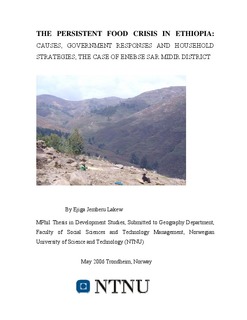| dc.description.abstract | This study looks into the underlying causes of household food shortage and coping and survival strategies of households. It also analyzes government intervention undertaken to address the problem. It was based on a field survey in three peasant associations of the Enebse Sar Midir district in Amhara Region.
The findings of this study show that various and interrelated factors are responsible for the problem of household food shortage. There are many natural predisposing factors such as drought, environmental degradation, hailstorm, crop pests, and animal diseases. Drought and environmental degradation are the most prominent natural causes in the lowland and highland areas respectively. Furthermore, there are many socio-economic constraints such as lack of infrastructural services like credit, marketing and transport communications; population pressure and shortage of farmland; traditional farming systems and practices; and lack of productive assets. Government inappropriate strategies are also found to be aggravating factors.
Given their capacity and available opportunities households try to implement different coping and survival strategies to handle the stress situation. There are some coping strategies adopted to minimize the impact of livelihood shocks which include selling of assets like livestock and wood, petty trading, handicrafts, and agricultural diversifications. When people become more and more vulnerable all these coping strategies become exhausted and their strategies are limited to survival or to combat destitution and death. The main survival strategies experienced are out migration, engaging in daily labor, food aid, decreasing daily food intake and changing food stuff, and social networks or support from relatives and friends.
There are some limited activities undertaken by the government to address the food crisis which include agricultural extension, water harvest, resettlement, safety net programs, credit services, and enhancing income generating schemes. However, even the very few activities carried out are not only ineffective but also disrupt farmers’ normal activities and aggravate the problem. These programs were designed at the top and imposed upon to the people at the grassroots. People have no any say; they are simply required to implement the imposed activities to them in mass. Most often, what the government doing is quite irrelevant to what the people need. The consequence has been a failure and worsening of the situation. For instance, the water harvest program which has been implemented widely with barely available resources is conflicting with other peoples’ activities and found to be irrelevant in the studied communities. Many chronically food insecure households who are supposed to resettle to the region’s resettlement sites but did not accept the resettlement are prohibited to get relief food aid.
Therefore, It is recommended that to achieve household food security or achieve sustainable household livelihood in general: program formulation and implementation should be participatory; alternative sources of income generating schemes should be strengthened; efforts should be made to develop medium and large scale irrigation projects; the severe environmental degradation and population pressures requires considerable attention; and agricultural input and output marketing systems should be improved. | nb_NO |
